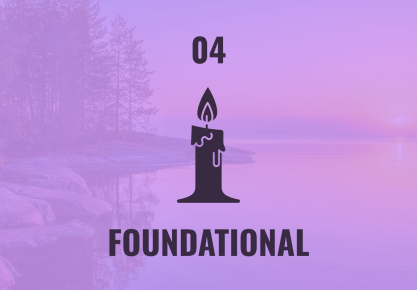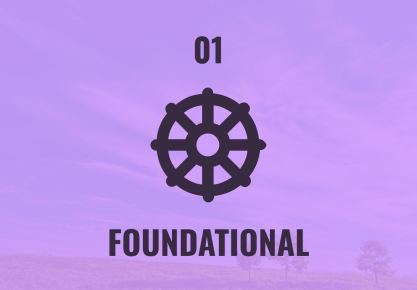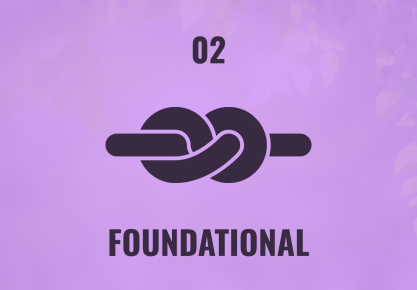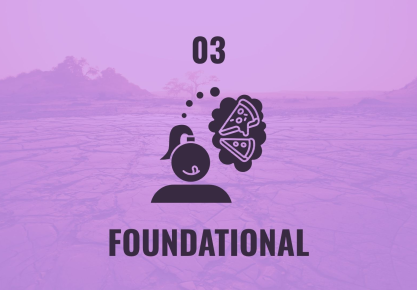If you’re new to the Dharma, we recommend reading our foundational posts first: Post 1: What is Buddhism?, Post 2: The First Noble Truth: Understanding Suffering (Dukkha) Explained, and Post 3: The Second Noble Truth: The Root of Craving (Samudaya) Explained
We have completed the first three phases of the Buddha’s core teaching:
- Diagnosis (Dukkha): Life involves inherent instability.
- Cause (Samudaya): This instability becomes suffering due to our craving (Tanha).
- Prognosis (Nirodha): It is possible to end craving, which leads to Nirvana.
The last and most important step is the solution. The Fourth Noble Truth gives a clear, practical guide to reach Nirodha. It is the heart of everything taught at Skylike Minds.
The Fourth Noble Truth states: There is a path leading to the cessation of suffering (Magga).
Welcome to Post 5 of the Skylike Minds Foundational Series.
The Prescription: What is Magga?
The Pāli word Magga simply means ‘path’ or ‘way’. The Fourth Noble Truth shows the exact way of living and training your mind needed to put out the fire of craving (Tanha) for good.
This path is called the Noble Eightfold Path. It is known as a Middle Way, which avoids the extremes of chasing pleasure (the life the Buddha left as a prince) and harsh self-denial (the tough life he tried as a wandering monk). The Middle Way is practical, realistic, and open to everyone.
The Two Core Principles of the Path
The entire Noble Eightfold Path can be condensed into two fundamental principles:
- Stop Harming: This involves ethical conduct (physical and verbal) that prevents you from causing suffering to yourself or others.
- Start Cultivating: This means training your mind to replace cravings with focus, wisdom, and kindness.
The Noble Eightfold Path is a system in which each part supports the others: acting ethically calms your mind, and a calm, clear mind helps you act more ethically.
The Threefold Training of the Path
While there are eight different parts to the path, they are grouped into three practical, easy-to-understand sections that guide all practice. Knowing these three groups makes the whole system simpler.
1. The Wisdom Division (Panna)
This is the thinking foundation that gives you the right way to see reality.
- Right Understanding (Samma Ditthi): The realisation of the Four Noble Truths. Seeing things as they truly are (impermanent, unstable, non-self).
- Right Thought (Samma Sankappa): Training your mind to swap thoughts based on greed, hatred, and confusion with thoughts based on generosity, kindness, and not harming others.
2. The Ethical Conduct Division (Sīla)
This is the foundation for how we act, guiding what we do, say, and how we make a living, so we do not harm ourselves or others.
- Right Speech (Samma Vaca): Speaking truthfully, kindly, usefully, and avoiding slander or harsh words.
- Right Action (Samma Kammanta): Not doing harmful things like stealing, killing, or acting wrongly in sexual matters.
- Right Livelihood (Samma Ajiva): Earning a living in a way that does not cause harm to other beings.
3. The Mental Discipline Division (Samādhi)
This is the meditation foundation, giving you the tools to focus your mind and see things clearly.
- Right Effort (Samma Vayama): Building up healthy states of mind and letting go of unhealthy ones.
- Right Mindfulness (Samma Sati): Maintaining clear awareness of the present moment (body, feelings, mind, phenomena).
- Right Concentration (Samma Samādhi): Learning to focus deeply during meditation.
“Just as the ocean has only one taste, the taste of salt, so the Dharma has only one taste, the taste of freedom.” — The Buddha
The Path is Not Linear
A common mistake is thinking the eight steps must be followed strictly in order. This is not true. The path is whole, meaning all eight parts support each other simultaneously.
- Right Mindfulness (mental training) helps you see when you are about to engage in Right Speech (ethical conduct).
- Right Livelihood (ethical conduct) reduces your stress and inner conflict, making Right Concentration (meditation) much easier.
There are eight parts of one connected practice meant to bring your whole life—mind, speech, and body—together with the main goal of Nirodha.
Practical Application: Where to Begin
The eight steps can seem complicated. The Buddha gave simple advice: for beginners, start with the parts you can control right away.
1. Start with Right Understanding
Right Understanding means accepting the first three Noble Truths you just learned. You do not need to understand everything perfectly, just be willing to accept the idea: “Craving causes my suffering.” This realisation gives you the important motivation to start the real work.
2. Focus on Right Speech
The easiest and quickest part to use is often Right Speech. Our words cause a lot of suffering in the world and in our own minds.
- Practice for Today: For the next few hours, try to avoid two things: gossip and harsh criticism (of yourself or others). A reduced sense of inner stress will give you quick positive results, making you more likely to stick with the rest of the path.
3. Commit to Right Mindfulness
The whole path is built on Right Mindfulness (Samma Sati). This is the key that opens up the other seven parts, because it gives you the focus and awareness you need to make good choices at every moment.
- Mindfulness is the ‘Path’ itself: When you are fully mindful, you understand clearly, you speak carefully, and you act ethically. The whole path works through being aware in each moment.
This is why, in our series, the practical practice posts will focus heavily on cultivating mindfulness.
“The Middle Way is the way of practice that leads to the cooling of the flames of passion.” — Buddhist Text
Breaking Down the Eight Elements
To help you prepare for the deeper posts to come, here is a brief look at the three divisions and the elements we will explore:
| Division | Elements | What It Cultivates |
|---|---|---|
| Wisdom (Panna) | Understanding, Thought | Vision and Insight |
| Ethical Conduct (Sīla) | Speech, Action, Livelihood | Compassion and Moral Integrity |
| Mental Discipline (Samādhi) | Effort, Mindfulness, Concentration | Mental Focus and Inner Calm |
We have separate posts for the key ethical parts and the important mental training steps because they need clear, practical instructions.
The Bridge to the Practice Posts
The Fourth Noble Truth is the perfect guide. It gives the promise (Nirodha) and the steps (Eightfold Path). Now is the time to look closely at how to apply ethical principles in real life, starting with what you do every day.
Our series will now go into how to apply the ideas of the Ethical Conduct Division, which quickly bring peace to your relationships and daily life.
Continue your journey with Post 6: Our next article explores the ethics of the path: The Noble Eightfold Path: An Introduction to the Middle Way. Read Post 6 Now




